Learning Chinese underground
Primary tabs
Submitted by David on Thu, 2006-06-15 09:00
Next time you’re on the MTR, how about learning Chinese characters from the route map? Ok, learning to read and write Chinese needs several years’ full-time study, but if you can spare a few minutes at least we can give you a good idea of how the characters came about. (If you aren’t near an MTR train, you can download a copy of the map here.)
The oldest characters are called pictographs, literally picture-characters, estimated to have originated over 10,000 years ago. If you’ve ever played pictionary and made little stick drawings, you’ll know what these are about. The red line on the map gives a couple of good examples. Down at the bottom left is ‘中環 Central’. The first of its characters is a vertical line piercing the middle of a square, meaning ‘centre’. You’ll find the same character in the Chinese name for China (中國), often translated as ‘Middle Kingdom’.
Back to the MTR map, and follow the red line almost to the end, where you’ll see ‘大窩口 Tai Wo Hau’. This station name has two pictographs. The first, Tai, means big, and is a picture of a stick man holding his arms out wide – think of all those fishermen’s ‘the one that got away’ stories. The third character is Hau, meaning mouth.
After pictographs came ideographs, characters that are able to convey a concept instead of simply representing a physical object. These are believed to have appeared around 5-6,000 years ago. Look at the red line on the map, and you'll find a couple of ideographs that use the pictograph character Tai mentioned above. First is the ‘Tsim’ in ‘尖沙咀 Tsim Sha Tsui’. It means ‘sharp’ or ‘pointed’, and is formed from the character for ‘small’ drawn above the character for ‘big’. Big tapering to small gives the sense of something pointy.
Up at the top of the red line you should be able to see ‘美孚 Mei Foo’. The first character Mei means beautiful or admirable, and is formed from two pictographs, Yeung (sheep or goat) above Tai. Volume 1 of ‘Fun with Chinese Characters’ gives the following explanation: ‘This beautifully proportioned character is shaped from ‘sheep’ and ‘big’. ‘Big’ originally represented a person grown big; the sheep is an animal admired for its peace-loving virtue. Ideographically, a mature person who has the mild and gentle disposition of a sheep is regarded as beautiful, admirable.’ If you are from Wales or New Zealand, you may be able to suggest an alternative ideographic interpretation!
Around 3300 years ago there was an explosion in the number of Chinese characters when a type of phonetic script was invented. They are known as ‘determinative-phonetic characters’. That mouthful means that two or more existing characters are combined to give a new character and meaning. One part of this new character gives you a clue what it means (the determinative part), and the other gives you a clue what it sounds like (the phonetic part).
Let’s look to ‘金鐘 Admiralty’ station on the blue line for an example. The first of the Chinese characters is Gum, meaning Gold in particular, or metal in general (our previous article explains why the Chinese and English names for the station differ). Now we introduce another character ‘同Tung’, which means together. Are you still with us .... now look along two stations to the right of Admiralty and you should see ‘銅鑼灣 Causeway Bay’. You’ll see the first character is formed from Gum and Tung, suggesting it will have a metallic meaning, and sound like Tung. In fact it means ‘copper’ and is also pronounced Tung.
For another example look for ‘鑽石山Diamond Hill’ at the top of the green line. Do you see the first character 鑽 has the same Gum on the left half, but the right half looks different? The right half is the character ‘贊 Jaan’ meaning ‘help’ or ‘assist’. So the combination should give us a character with a metallic meaning and a sound like Jaan. In fact it means diamond and is pronounced ‘juen’. It’s a fair guess that when the character was developed, diamond’s strength led it to be considered a metal. However you can also see from this example that the sounds have drifted over the years, to the point that some apparently connected characters don’t sound the same at all. Other times you’ll find that if you pronounce them using the Beijing dialect they do sound similar, but in say Cantonese they don’t.
As a final example, check ‘深水埗 Sham Shui Po’ on the red line. The second character Shui is a pictograph meaning water. It is also used in many other characters to indicate a liquid or watery meaning, and inthose cases it is abbreviated to three vertical drops. You can see them on the left of the ‘Sham’ character in this station's name. As you’d expect, a harbour like Hong Kong needs a lot of watery words. Look around the MTR map and you’ll find many characters have those three drips of water.

